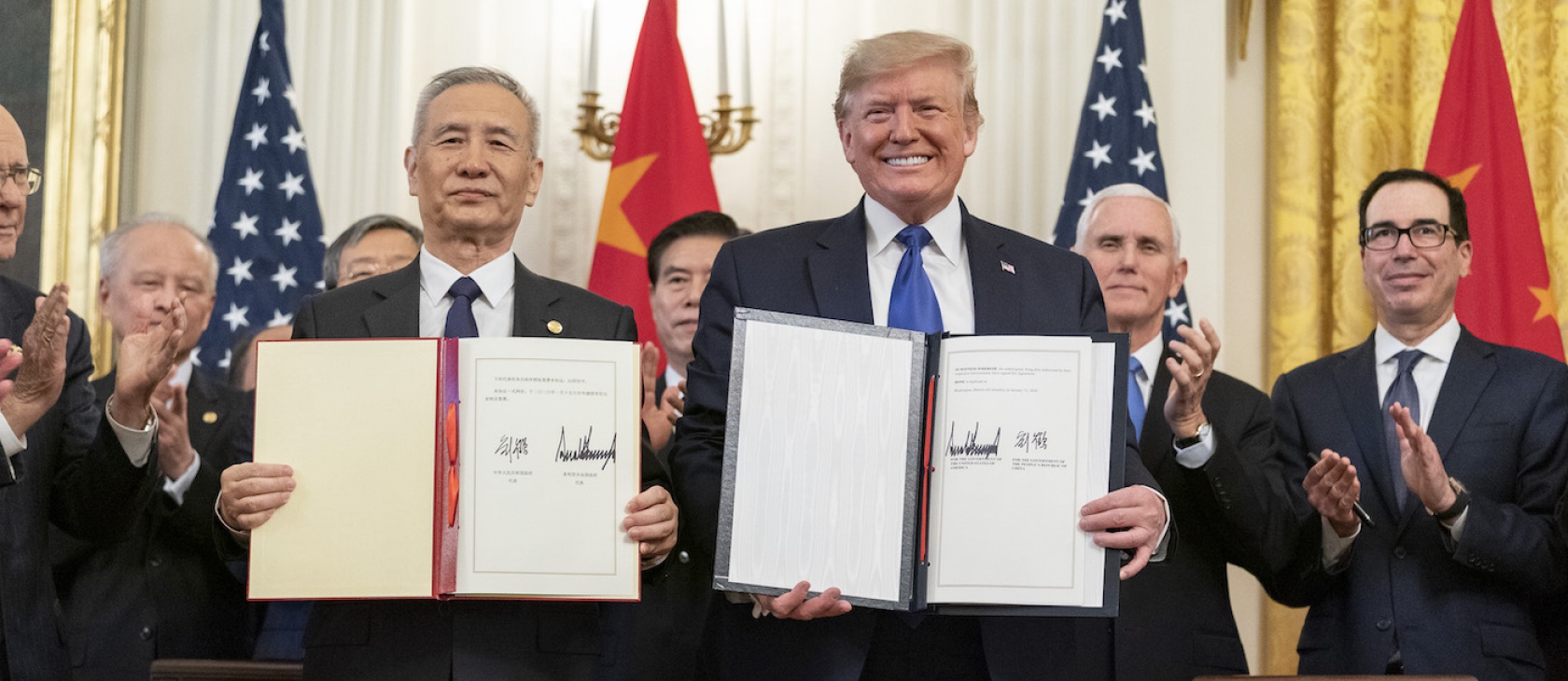On Wednesday, President Donald Trump and Chinese Vice-Premier Liu He signed “Phase One” of a two-part trade agreement between the United States and China. Here are the facts you need to know.
What does the new trade deal mean for both countries?
The agreement cools, or at least pauses, the 18-month-long trade war between the two nations. The world’s two largest economies commit to opening their markets: The U.S. reduces tariffs, while China agrees to purchase a specific amount of goods and services, specified by sector, and to reform its encroachment of intellectual property. The text of the agreement, which was kept secret until the signing, is available online and is described by the U.S. Trade Representative’s office in a series of fact sheets.
What does China promise in “Phase One”?
China promises to purchase an additional $200 billion of certain goods and services over and above the $186 billion it spent in 2017 (before the trade war ratcheted up), to crack down on intellectual property theft, and to remove certain structural barriers to U.S. products.
China vows to spend an additional $32 billion over 2017 levels on U.S. agriculture, $52.4 billion on energy, and $37.9 billion on U.S. services like IP and tourism. If China fulfills the agreement, Chinese authorities will spend an additional $77.7 billion in 2020, raising the amount of U.S. exports bound for China to $263 billion, and $123 billion in 2021, when U.S. exports will hit $309 billion. “Either amount would mark a record-breaking acceleration for U.S. exports to China,” reported CNBC.
A 24-page annex in the agreement specifies which goods and services that China may purchase within each sector to comply with the agreement. For instance, China agrees to purchase an additional $32 billion in agricultural goods, including: oilseeds, meat, cereals, cotton, and seafood. The agreement further breaks down the goods that fall into each of these categories in seven pages of trade text.
Most significantly, the agreement spells out rules about how China will counter intellectual property theft and technology transfer. China agrees to draw up plans to stop IP theft, including ending the forced disclosure of proprietary information during government investigations and shifting the burden of proof in IP theft cases to the defendant. These measures begin to address the concerns that lay at the heart of the Office of the U.S. Trade Representative’s (USTR) Section 301 Report. The rules and procedures in “Phase One” go beyond those specified by the World Trade Organization and could assist in gauging Chinese compliance.
Aside from these provisions, the agreement eliminates structural barriers to trade by removing, for instance, Chinese objections to genetically modified organisms (GMOs) in the agricultural portion of the agreement, and by eradicating equity caps on U.S. insurance firms and financial managers. “Phase One” also requires China to compensate U.S. companies “for unreasonable delays that occur in granting the patent or during pharmaceutical product marketing approvals.”
Liu hinted that Beijing may exceed these targets during his speech at the signing ceremony. “China will open itself even wider,” he said. But skepticism is not unwarranted. China regularly reneges on trade (and other international) agreements and, while “the enforcement element of the deal looks rather robust,” it is “not airtight,” said Matthew P. Goodman of the Center for Strategic and International Studies.
What did the United States promise in the “Phase One” agreement?
The U.S. halves its tariffs on $120 billion worth of Chinese imports, from 15 percent to 7.5 percent. However, a 25 percent punitive tariff remains on an additional $250 billion of Chinese goods. And tariffs can be hiked in the event of future disagreements. Chad Bown of the Peterson Institute for International Economics said high tariffs are “the new normal.’’ Deborah Elms, executive director at consultancy Asian Trade Centre, agreed that “we’re stuck with tariffs for a very long time.” Another analyst - Peter Boockvar of Bleakley Advisory Group – used a more colorful turn-of-phrase: “These tariffs have now become a roach motel,” he said.
Has the U.S. taken additional steps to cool the trade war with China?
Although it is not part of the agreement, the United States dropped charges that China is manipulating its currency earlier in the week. President Trump decided not to impose tariffs on an additional $160 billion of Chinese exports last December.
Is this a free trade agreement?
No, “Phase One” does not represent free trade. It directs China to purchase a specific amount of goods or services and provides for both nations to open their markets from the present stand-off. “The U.S.-China phase-one deal is essentially a trade truce, with large state-directed purchases attached,” said economist Mary Lovely of the Peterson Institute for International Economics. “Although the agreement attempts to shift China’s political economy to a more market-based one, free from government intervention, there is nothing market-based about these government-directed purchases,” said James Jay Carafano of the Heritage Foundation. Others view the deal more positively, as the president wringing concessions out of China’s notoriously closed markets and nibbling away at its mercantilist double standards. “Trade is always good news,” said U.S. Senator Ben Sasse, R-NE. Trump ally Steve Bannon said the president “broke the Chinese Communist Party.” But ultimately, “People should understand this is a political deal, not an economic deal,” said AEI analyst Derek Scissors.
What does “Phase One” not cover?
The agreement does not deal with China’s deep subsidies for domestic industries, something left to the next agreement.
How have global markets responded to “Phase One”?
Investors have responded to the “Phase One” agreement with tremendous relief, fueling a spike in global stock markets. The Dow Jones Industrial Average cracked a record, reaching 29,000 for the first time ever on Wednesday. European stocks surged to a record high on Thursday, as the Stoxx Europe 600 closed at 420.52. Oil futures also rose on the news of the agreement’s mandatory energy purchases.
What will the initial U.S.-China agreement mean to both economies in the long term?
Economists, as always, are split. Lawrence Kudlow, the director of President Trump’s National Economic Council, forecasts that the agreement will “help grow our economy faster. We reckon in 2020 and 2021, at least a half a point of additional GDP, which will probably translate into another million jobs.” On the other hand, some believe the lingering tariffs and the potential for additional trade disputes could render the gains moot. “The modest scale of the rollback of existing tariffs means that the deal will provide little, if any, boost to U.S. GDP growth in 2020,” said Paul Ashworth, chief U.S. economist at Capital Economics.
Is there potential for the trade war with China to heat up again?
Yes, President Trump has said the terms of the agreement are “fully enforceable,” meaning that tariffs could rise if he believes China is failing to live up to its side of the agreement. The U.S. is still directing taxpayer funds to fight Chinese domination of sensitive industries. Congressional plans to steer $1.25 billion to U.S. 5G companies developing alternatives to Huawei suggest tensions are far from over. And significant sources of conflict remain unaddressed by the deal.
How does the agreement impact global free trade?
As “Phase One” moved closer to the signing stage, President Trump threatened to impose new tariffs on European industries – in order to force the EU to lower barriers against U.S. goods. The move indicates that Donald Trump fights the trade war one front at a time.
When will “Phase Two” of the trade agreement between the U.S. and China be completed?
Kudlow said negotiators would get to work immediately on the next part of the agreement. However, most experts believe there will be a lull in the talks, and that there is no likelihood of completing the next round of negotiations during President Trump’s first term in office.




